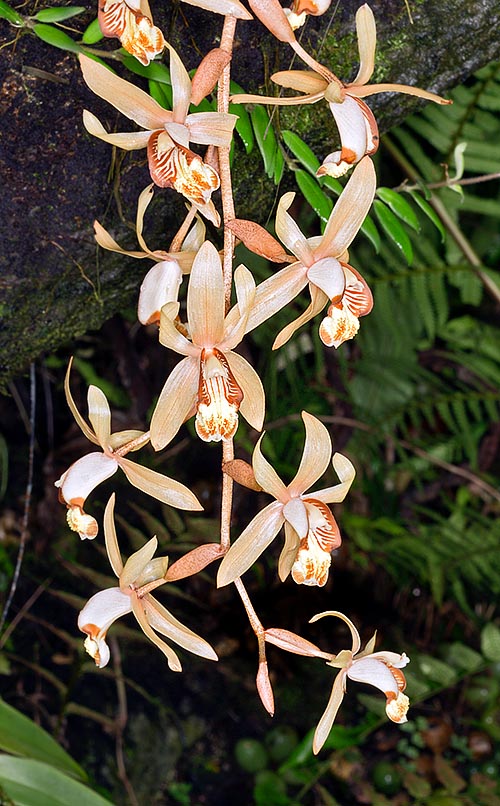Family : Orchidaceae

Text © Pietro Puccio

English translation by Mario Beltramini

The Coelogyne tomentosa drooping inflorescences reach 30-50 cm © Giuseppe Mazza
The name of the genus is the combination of the Greek terms “koilos” = hollow and “gyne” female, with reference to the concave stigma; the name of the species is the Latin adjective “tomentosus, a, um” = tomentose, with reference to the pubescent ovarium.
Common names: necklace orchid (English).
The Coelogyne tomentosa Lindl. (1854) is an epiphytic herbaceous species with creeping rhizome from which originate ovoid pseudobulbs, 5-10 cm long and of about 3 cm of diameter, with at the apex, on a 7-8 cm long petiole, 1-2 lanceolate leaves with pointed apex, plicate, 20-50 cm long and 3-8 cm broad.
Drooping terminal inflorescences, 30-50 cm long, which originate from a basal bud producing only leaves and rudimental pseudobulbs, carrying 10-30 flowers opening at the same time, of about 6 cm of diameter, on an about 2 cm long pedicel, with persistent bracts about 2,5 cm long; sepals and petals are of cream yellow colour, the labellum is brown with paler veins and yellow lamellae. The sepals are lanceolate with pointed apex, about 3 cm long and 0,7 cm broad; the oblong lanceolate petals with pointed apex are 2,5 cm long and 0,8 cm broad, the trilobed labellum is 2,5 cm long and 1,7 cm broad with rounded and erect lateral lobes on the sides of the column and ovate median lobe with pointed apex run by three wavy lamellae, with other two lateral ones in the terminal part. It easily reproduces by division with each section provided with at least 3-4 pseudobulbs.
Easy to cultivate species, therefore suitable also for beginners, which may flower several times during the year, even if more frequently in summer, with odorous flowers of relatively short duration, 12-15 days. It requires a warm humid climate with temperatures of 22-30 °C, humidity 70-90% and partial shade in summer, slightly lower temperatures in winter, 15-20 °C, even if it can stand, if completely dry, temperatures close to 0 °C for a very short period, maximum luminosity, also filtered solar light, it does not bloom with insufficient light, and humidity 60-80%, it is essential in all seasons a good air circulation. The watering must be frequent in summer, slightly more reduced in winter, keeping the compost constantly humid, but without stagnations which may cause rottenness. For the watering and nebulisations is to be utilized rain water, from reverse osmosis or demineralised; the fertilizations, appropriately distributed in way to avoid salts accumulation, are to be done during the vegetative period preferably with hydro-soluble balanced products, with microelements, at half of the dosage, or less, suggested on the package. It is cultivable in pots or suspended baskets utilizing compost perfectly draining and aerated which may be forms by a mix of medium sliced bark, sphagnum, coir and fragments of charcoal. Possible divisions and repotting are to be done by the vegetative restart when the new roots do appear.
The species is reported into the appendix II of the CITES (species whose trade is ruled at international level).
Synonyms: Coelogyne massangeana Rchb.f. (1878); Pleione massangeana (Rchb.f.) Kuntze (1891); Pleione tomentosa (Lindl.) Kuntze (1891); Coelogyne densiflora Ridl. (1903); Coelogyne dayana var. massangeana Ridl. (1907); Coelogyne cymbidioides Ridl. (1908); Coelogyne tomentosa var. cymbidioides Ridl. (1924).
→ For general notions about ORCHIDACEAE please click here.
